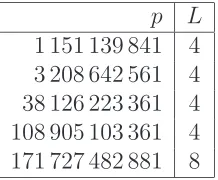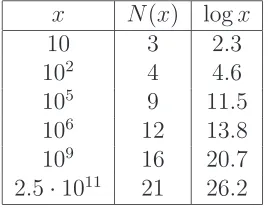23 11
Article 06.3.8
Journal of Integer Sequences, Vol. 9 (2006), 2
3 6 1 47
All Elite Primes Up to 250 Billion
Alain Chaumont
Laboratoire de Mod´elisation et Simulations Mol´eculaires “MSM”
Universit´e Louis Pasteur
A prime number p is called elite if only finitely many Fermat numbers 22 n
+ 1 are quadratic residues ofp. Previously only the interval up to 109 was systematically
searched for elite primes and 16 such primes were found. We extended this research up to 2.5·1011 and found five further elites, among which 1 151 139 841 is the smallest
and 171 727 482 881 the largest.
1
Introduction
Let {Fn} with Fn := 22 n
+ 1 denote the sequence of Fermat numbers. Further details on these numbers, some of their properties and open problems can be found, e.g., in the work of Hardy and Wright [3], in section A3 of Guy’s problem book [2] or in the 17 lectures on this topic by Kˇr´iˇzek, Luca and Somer [4].
We call a prime numberpelite, if there is an integer indexmfor which allFnwithn > m
are quadratic non-residues ofp, i.e., there is no solution to the congurence x2
for n > m. Alexander Aigner [1], who first defined and studied elite primes, discovered 14 such numbers with values less than 35 million. Two further primes less than 109
were found by the second author [6]. All these primes are summarized in Table 1.
elite primes discovered
3, 5, 7, 41, 15361, 23041, 26881, 61441, 87041,
163841, 544001, 604801, 6684673, 14172161 Aigner (1986) 159318017, 446960641 M¨uller (2005)
Table 1: All elite primes <109
A further important result was given by Kˇr´iˇzek, Luca and Somer [5] with a theorem assuring that the series S of the reciprocals of all elite primes is convergent. They proved their claim by showing that the number N(x) of elite primes less than or equal to x is asymptotically bounded by the same functions as prime twins are, i.e.,
N(x) = O
Further computations of larger elite primes [6] suggested moreover that the asymptotic (1) is rather rough and could perhaps be lowered to
N(x) =O((logx)c), (2)
with an option for c = 1. This would mean that all larger interval of the form [10n,10n+1 ] should contain a more or less constant number of elite primes.
The purpose of the project presented in this paper was to find all elite primes up to 2.5·1011
. These results seem to confirm conjecture (2).
2
Preliminaries
From the well-known relation for Fermat numbers
Fn+1 = (Fn−1)
2
+ 1 (3)
it is obvious that for any prime number p, the residues Fn modp are ultimately periodic.
Aigner [1] showed that for any prime number written in the form p = 2rh+ 1 with r ∈ N
and h ≥ 1 odd, this period begins at the latest with the term Fr. We call L the length of
the Fermat period, if L is the smallest natural number fulfilling the congruence Fr+L ≡ Fr
(modp). The termsFr+ν modp with ν = 0, . . . , L−1 are called Fermat remainders of p.
Therefore, a prime numberpis elite if and only if all L Fermat remainders are quadratic non-residues modulo p. It is moreover known that for all p >10 it is a necessary condition for eliteness that L is an even number smaller than p−1
4 (compare [1]).
3
The method
First, we constructed all prime numbers in the range up to 250 billion with the help of a vari-ant of the well-known sieve method of Erathostenes. It is proved in [1] that prime numbers of the formp= 120k+awithk ∈Nand a∈ {11,13,19,23,31,47,59,61,71,79,91,109,119}
cannot be elite, so that a simple preliminary congruential test combined with some ele-mentary results on quadratic residues already allowed one to eliminate a large number of candidates. All the remaining prime numbers were tested one by one using an algorithm based on the following necessary and sufficient condition:
Theorem 3.1. Let p= 2rh+ 1 be a prime number with h odd. Then p is elite if and only
if every Fermat remainder has a multiplicative order modulo p being a multiple of2r.
So, if f denotes a given Fermat remainder of a primep= 2rh+ 1, the algorithm checked
whether the congruence
f2kh
≡1 (modp) (4)
is solvable only for k = r. If this is fulfilled, equation (4) is solved for the next Fermat remainder of p and so on, until either an entire Fermat period is successfully checked and hence p is elite, or a Fermat remainder f is found with k < r in (4) leading to a negative answer regarding the eliteness of p(compare [6]).
As in all known cases elite primes have Fermat periods of rather small length and moreover almost all non-elite primes in our research presented rather quickly a Fermat remainder contradicting the sufficient condition of theorem 3.1, the computational effort needed for testing a given p turned out to be on average equivalent to five Fermat-tests.
4
The results
In the interval [109
,2.5·1011
] we found five elite primes. Two primes were found between 109
and 1010
, while the set of elite primes contained in the interval [1010
,3·1010
] is empty. Only one further elite was discovered smaller than 100 billion. Two supplementary primes turned up between 1011
and 2·1011
. The final subinterval again turned out to be “elite-free”. These elite primes are listed in Table2together with the respective lengthLof their Fermat period.
So, there are 21 elite prime numbers less than 250 billion and in total 45 such primes known to date.
Table 2: All elite primes between 109
The results of this section as well as the known numbers presented in the introduction are summarized in Sloane’s OEISA102742.
The several computations were run on a AMD Sempron 2600 XP+ and a Pentium-III-processed PC. A total CPU-time of about 1680 hours was needed to complete this project.
5
Interpretations and conjectures
It was conjectured that there are infinitely many elite primes. If this is so, it is certainly interesting to know more about their distribution among natural numbers. Table 3 gives a comparison of N(x) and logx for some x in the interval [10,2.5·1011
] suggesting that the growth of both functions is perhaps asymptotically the same.
x N(x) logx
10 3 2.3
102
4 4.6
105
9 11.5
106
12 13.8
109
16 20.7
2.5·1011
21 26.2
Table 3: Comparison of N(x) and logx
Moreover, with the bound of N(x) proved by Kˇr´iˇzek and al. [5] we can now give the following value of the sum S of the series of reciprocals of all elite primes:
0.70≤S ≤0.74, (5)
i.e., the first digit after the decimal point is settled. Our conjectured bound would lead to seven more digits:
S = 0.700764011±0.12·10−8. (6)
References
[1] A. Aigner, ¨Uber Primzahlen, nach denen (fast) alle Fermatzahlen quadratische Nichtreste sind, Monatsh. Math. 101 (1987), 85–93.
[2] R. K. Guy,Unsolved Problem in Number Theory, Springer, 2004.
[3] G. H. Hardy, E. L. Wright,An Introduction to the Theory of Numbers, Oxford University Press, 1979.
[5] M. Kˇr´iˇzek, F. Luca, L. Somer, On the convergence of series of reciprocals of primes related to the Fermat numbers. J. Number Theory 97 (2002), 95–112.
[6] T. M¨uller, Searching for large elite primes,Experiment. Math. 15:2 (2006), 183–186.
[7] N. J. A. Sloane, Online Encyclopedia of Integer Sequences (OEIS), electronically pub-lished at: http://www.research.att.com/~njas/sequences/.
2000 Mathematics Subject Classification: Primary 11A15; Secondary 11A41.
Keywords: elite primes, Fermat Numbers.
(Concerned with sequenceA102742.)
Received January 18 2006; revised version received August 21 2006. Published inJournal of Integer Sequences, August 21 2006.

